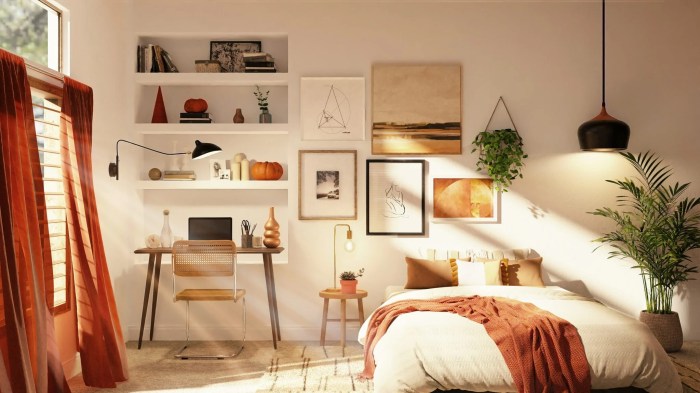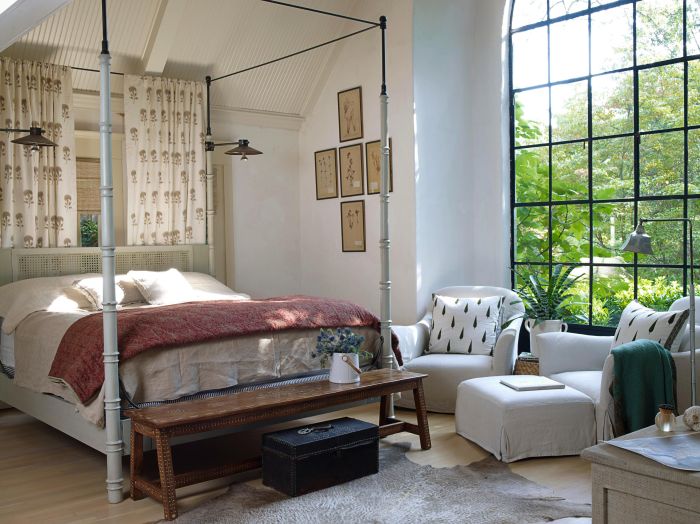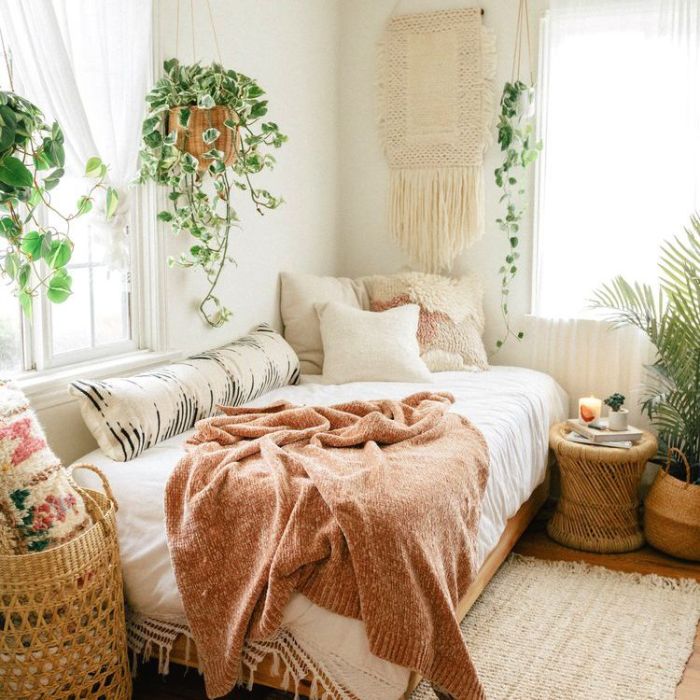Transforming your bedroom into a sanctuary of comfort and relaxation is easier than you think. This guide provides seven simple yet impactful ideas to create a cozy haven, focusing on the interplay of color, texture, lighting, and furniture arrangement. Learn how to cultivate a space that promotes rest and rejuvenation, turning your bedroom into your personal retreat.
We’ll explore the psychology of color and texture, guiding you through the selection of warm hues and inviting materials. Understanding different lighting types and their impact on ambiance is key, as is the strategic placement of furniture to maximize both space and comfort. By the end, you’ll have a clear roadmap for designing a bedroom that perfectly reflects your personal style and prioritizes your well-being.
Color Palette & Texture Selection for a Cozy Bedroom

Creating a truly cozy bedroom involves a careful consideration of both color and texture. The right combination can transform your space into a haven of comfort and relaxation, promoting a sense of calm and well-being. We’ll explore how strategic color choices and textural elements can achieve this.
Warm Color Palette for a Cozy Bedroom
A warm color palette is fundamental to achieving a cozy atmosphere. Warm colors evoke feelings of comfort, security, and intimacy. Here’s a sample palette with hex codes and psychological impact:
- Warm White (#F8F4E7): This off-white provides a soft, inviting base, creating a feeling of spaciousness without being stark. It allows other colors to shine while maintaining a sense of calm.
- Soft Taupe (#A08A7E): This muted brown adds depth and warmth without feeling heavy. Taupe is a versatile neutral that pairs well with various accent colors and textures.
- Dusty Rose (#B28C85): A subtle blush pink introduces a touch of romance and softness. It adds a gentle femininity without being overwhelming.
- Deep Teal (#008080): This jewel tone adds a sophisticated touch and creates a sense of tranquility. Used sparingly as an accent, it balances the warmer hues.
Textural Elements for a Cozy Bedroom
Texture plays a crucial role in creating a cozy feel. Tactile elements add another layer of comfort and visual interest, enhancing the overall sense of warmth and relaxation.
- Faux Fur: Faux fur throws and rugs offer exceptional softness and visual warmth. The plush texture invites touch and creates a luxurious feel.
- Velvet: Velvet’s smooth, luxurious feel and rich sheen add a touch of elegance and sophistication. Velvet cushions and curtains create a decadent atmosphere.
- Linen: Linen bedding provides a natural, breathable texture. Its slightly rough texture adds a touch of rustic charm while remaining comfortable.
- Knitted Textiles: Knitted blankets and throws add a handcrafted, homey touch. The chunky knit adds visual and tactile interest.
Comparison of Textures for Bedding, Rugs, and Wall Coverings
The following table compares various textures, considering their pros and cons in terms of comfort and maintenance:
| Texture | Material | Pros | Cons |
|---|---|---|---|
| Faux Fur | Polyester, Acrylic | Soft, warm, visually appealing, relatively inexpensive | Can shed, requires regular cleaning, may not be suitable for hot climates |
| Velvet | Cotton, Silk, Polyester | Luxurious feel, rich sheen, adds elegance | Can be prone to stains, requires careful cleaning, may be less breathable |
| Linen | Flax | Breathable, durable, naturally hypoallergenic, ages beautifully | Can wrinkle easily, requires ironing, may be more expensive |
| Knitted | Wool, Cotton, Acrylic | Warm, comfortable, adds a handcrafted feel | Can be prone to pilling, may require hand-washing, can be bulky |
| Woven Cotton | Cotton | Soft, breathable, easy to care for, affordable | Can wrinkle, may not be as warm as other options |
| Textured Plaster | Plaster, Paint | Adds visual interest to walls, durable | Can be difficult to clean, more expensive to install |
Lighting Design for Ambiance and Relaxation

Creating the perfect cozy bedroom relies heavily on thoughtful lighting design. The right lighting scheme can transform your space from simply functional to a haven of relaxation and comfort. By layering different types of lighting, you can control the mood and atmosphere, enhancing the overall feeling of warmth and serenity.
Effective bedroom lighting utilizes a combination of ambient, task, and accent lighting to create a multi-layered approach. Ambient lighting provides overall illumination, task lighting focuses light on specific areas for activities like reading, and accent lighting highlights architectural features or decorative elements to add visual interest. This layered approach allows for flexibility and control over the atmosphere, catering to different needs and moods throughout the day.
Types of Lighting and Their Application in a Cozy Bedroom
Ambient lighting sets the overall mood and tone of the room. It should be soft and diffused, avoiding harsh shadows. Examples include recessed ceiling lights, or a statement chandelier with a warm-toned bulb. Task lighting, on the other hand, provides focused illumination for specific tasks, such as reading in bed or applying makeup at a vanity. Bedside lamps, desk lamps, and vanity lights fall into this category. Accent lighting adds visual interest and highlights specific features. This could involve strategically placed wall sconces, picture lights, or even string lights draped around a headboard.
Examples of Light Fixtures and Their Placement
A pair of bedside lamps with warm-white bulbs creates a comforting glow perfect for reading before sleep. Their placement should be symmetrical, flanking the bed for balanced illumination and a visually appealing arrangement. A floor lamp positioned in a corner can provide soft ambient light and additional reading light if needed, especially beneficial for larger bedrooms. String lights draped along a window or headboard add a whimsical, romantic touch, contributing to a relaxing ambiance. Avoid harsh overhead lighting; instead, prioritize softer, warmer light sources. Consider using dimmer switches to adjust the intensity of your lighting, allowing you to tailor the atmosphere to your preferences.
A Sample Lighting Plan for a Cozy Bedroom
- Ambient Lighting: Recessed ceiling lights with dimmable warm-white LED bulbs (3000K) provide a soft, even base level of illumination. This creates a calm and inviting atmosphere throughout the room.
- Task Lighting: Two bedside lamps with 40-watt warm-white bulbs (2700K) placed symmetrically on nightstands offer focused light for reading in bed. This localized light is perfect for pre-sleep activities and creates a sense of intimacy.
- Accent Lighting: A set of fairy lights draped around the headboard adds a touch of whimsy and romance, creating a soft, gentle glow. This adds a touch of personality and creates a visually appealing focal point.
Furniture Arrangement and Decor for Maximum Comfort

Creating a truly cozy bedroom relies heavily on thoughtful furniture placement. The arrangement of your furniture directly impacts not only the functionality of the space but also the overall feeling of warmth and intimacy. A well-planned layout can transform a simple bedroom into a relaxing sanctuary.
The key to a cozy and functional bedroom is to prioritize comfort and flow. This means strategically placing furniture to maximize space while encouraging a sense of calm and relaxation. Careful consideration of traffic flow and the placement of key pieces like the bed, nightstands, and seating is crucial for achieving this balance.
Optimal Furniture Placement for Coziness
The placement of your bed is paramount. Ideally, it should be positioned to avoid direct drafts from windows or doors, and far enough from the walls to allow for easy access from both sides. Nightstands should be placed within easy reach, providing a convenient surface for lamps, books, and other personal items. If space allows, incorporating a comfortable armchair or seating area creates a designated spot for relaxation and reading, further enhancing the cozy atmosphere.
- Bed Placement: Position the bed against a wall, away from drafts, allowing for easy access from both sides. This creates a sense of security and provides ample space for movement.
- Nightstand Placement: Place nightstands on either side of the bed within arm’s reach. This ensures easy access to essentials like lamps, books, and water. Matching nightstands enhance symmetry and visual appeal.
- Seating Area: If space permits, include a comfortable armchair or small seating area with a side table. This creates a cozy reading nook or a quiet spot for relaxation. A soft throw blanket adds to the overall sense of comfort.
Visual Description of a Cozy Bedroom Layout
Imagine a bedroom painted in soft, muted tones. The bed, a plush queen-size with a high headboard, is positioned against the furthest wall, creating a focal point. Two matching nightstands flank the bed, each topped with a small table lamp emitting a warm, inviting glow. A plush armchair sits in a corner near a large window, draped with a thick, textured throw blanket. A small side table next to the armchair holds a reading lamp and a stack of books. The overall effect is one of calm, relaxed sophistication, where every element contributes to a feeling of warmth and comfort. The room is not cluttered; rather, it feels spacious and inviting, demonstrating the power of intentional furniture placement.
Closure

Creating a cozy bedroom is a journey of thoughtful design choices, each contributing to a harmonious and restful environment. By carefully considering color palettes, textures, lighting schemes, and furniture arrangements, you can craft a space that truly reflects your personal style and fosters relaxation. Remember, the key is to prioritize comfort and create a haven where you can unwind and recharge. Embrace the process, experiment with different elements, and enjoy the transformation of your bedroom into a personal sanctuary.